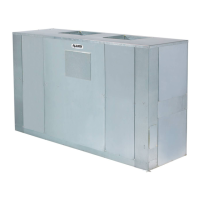Page 70
Sequence of Operation G21Q
A−EXPLANATION OF LENNOX’ MODEL NUMBER DESIGNATIONS:
The following is an explanation of Lennox’ model number designa
tions:
G21Q: Residential unit with a up flow cabinet and a multispeed blower
motor.
G21V: Residential unit with a up flow cabinet and an electronically con
trolled blower motor.
GSR21Q: Residential unit with down flow/horizontal cabinet and a multi
speed blower motor.
GSR21V: Residential unit with a down flow/horizontal cabinet and an
electronically controlled blower motor.
B−APPLICATION OF G21Q WITH GC3 IGNITION CONTROL
This flowchart is used to show the step by step sequence that takes place when
thermostat demand is sent to a G21Q. The sequence describes the actions of
devices in the unit which control blowers, fans, gas valve and other components
in the system. The sequence is outlined by numbered steps which correspond to
circled numbers on the adjacent diagram.
NOTE−This is a basic operation sequence for the G21Q. The thermostat shown
is a basic electromechanical thermostat .
Operation Sequence:
1− Line voltage feeds through door interlock switch S51. The blower access panel
must be in place to energize the unit.
2− Line voltage energizes transformer T1. Transformer T1 provides 24VAC power
to all unit controls, terminal strip and thermostat.
Heating:
3− Heating demand initiates at W1 in the thermostat. The heating demand ener
gizes K9 which closes N.O. K91. The heating demand then passes through
the primary gas limit S10, heat relay K91 and differential pressure switch
S72 enabling ignition control A3.
4− Combustion air blower B6 is energized for 30 +
5 seconds by ignition con
trol A3.
5− Gas valve opens and attempts for ignition occur.
6− Internal Watchguard is enabled only if ignition fails to light unit (5 tries). Watch
guard will break and remake thermostat demand in 60 + 5 minutes.
7− Fan timing control A28 is energized by gas valve GV1.
8− Spark stops .5 seconds after ignition is sensed or after 8.0 seconds if ignition
is not sensed. (Early GC3, in later versions and G891 spark for a full 8 sec
onds even if ignition is sensed).
9− Combustion air blower B6 is deenergized .5 seconds after ignition is sensed
or after 8.0 seconds if ignition is not sensed. (Early GC3, in later versions
and G891 the combustion air blower B6 is deenergized after 8 seconds).
10−After the adjustable time of 30 − 60 seconds of successful ignition A28 ener
gizes K36.
11− K361 N.O. closes energizing the blower B3 on heating speed and ACC terminal
of TB2 is energized.
End of Heating Demand:
12− Heating demand is satisfied.
13− Ignition control A3 is deenergized.
14− Gas valve GV1 closes. Pulse cycle stops.
15− Combustion air blower B6 is energized for 30 + 5 seconds post purge by ignition
control A3.
16− A28 continues to power blower motor B3 for the adjustable time of 120240 sec
onds.
17− After the adjustable delay, K36 is deenergized.
18− K361 closes deenergizing blower motor B3.
Blower Only:
19− Blower demand originates in the thermostat terminal G.
20− Blower contactor K3 is energized.
21− K31 N.O closes energizing blower (black tap).
22− K32 N.O. closes energizing ACC terminal on TB2 terminal strip.
Cooling Demand:
NOTE: Y TERMINAL ON LOW VOLTAGE TERMINAL STRIP IS USED FOR
CONNECTING THERMOSTAT TO OUTDOOR UNIT (JUNCTION
BLOCK). THE Y TERMINAL HAS NO INTERNAL CONNECTIONS TO
THE UNIT.
23− Blower demand originates in the thermostat terminal G.
24− Blower contactor K3 is energized.
25− K31 N.O closes energizing blower on cooling speed (black tap).
26− K32 N.O. closes energizing accessories terminal on TB2 terminal strip.
SingleStage or TwoStage Cooling With CCB1 (EBR1 Required)
See Table 20 for operating characteristics.
Continuous Low Blower Kit−Optional
27− S68 is a DPST switch.
28− One pole (S68−1) is connected to the blower (low speed tap).
29− The other pole (S68−2) is connected to the ACC terminal of the TB2 termi
nal block.
30− When the switch is energized S68−1,2 both close energizing the blower on
low speed and the ACC terminal. This assures a blower supply when op
tional accessories such as an electronic air cleaner operate.

